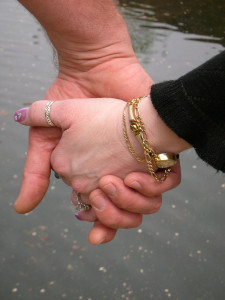Probably one of the greatest challenges for a fiction writer is writing emotional scenes that are genuine, believable, and moving—while steering clear of the sand traps of sappy, phony, and overdone. Why is it so hard to write an emotional scene that works? I think it’s because the human heart is subtle, so the writing must be incredibly subtle to work.
The Secret of Subtext
In real life, our emotional moments usually occur with less being said than is unsaid. At times of peak emotion, people feel vulnerable, and usually allude to what they mean rather than say it directly. Writers call such unspoken thoughts and feelings “subtext,” and powerful scenes are generally full of this stuff. So when you aim to create a dramatic scene, it’s better to hold back a bit on your character’s self-expression than give it full-throttle. The scene will be more true-to-life.
Was That a Violin?
 What makes a scene sappy, phony, or overdone is when an author tries too hard to get the emotion across. The amateur writer wants to make sure we understand that the character is enraged, or in love, or terrified, so a whole thesaurus of adjectives and adverbs gets trotted out to guarantee we get the point. Instead, what that causes in a reader, is the “eye-rolling reaction.” We resent an author trying to tug, for all she’s worth, on our heartstrings. We feel manipulated, just as we would in real life if someone turned on the fake tears. In fiction as in life, people insist on authenticity, or they walk away.
What makes a scene sappy, phony, or overdone is when an author tries too hard to get the emotion across. The amateur writer wants to make sure we understand that the character is enraged, or in love, or terrified, so a whole thesaurus of adjectives and adverbs gets trotted out to guarantee we get the point. Instead, what that causes in a reader, is the “eye-rolling reaction.” We resent an author trying to tug, for all she’s worth, on our heartstrings. We feel manipulated, just as we would in real life if someone turned on the fake tears. In fiction as in life, people insist on authenticity, or they walk away.
Authentic, Not ‘Emotional’
So make authenticity the aim in writing your emotional scene—rather than emotion itself. Make your characters talk like real people, and the emotion will come through without you exerting an effort. If you try to write emotion, the emotion will feel strained. It will come across as false. Instead, focus on writing like the characters would actually talk in that situation, and what will come through will be genuine and amazing.
Trim It
 Even after writing an emotional scene from this perspective, it’s usually necessary to trim it afterwards. You’ll probably have written more than was needed, more than a real person would actually say. I notice that even I do this, in spite of knowing the points I’m making here. Once I trim the dialog of everything repetitive or too demonstrative, only then does the dialog sound powerful and moving. But it does take revising to get the scene to that point, at least for most of us. Very few authors can write out a scene that is stellar in its first draft.
Even after writing an emotional scene from this perspective, it’s usually necessary to trim it afterwards. You’ll probably have written more than was needed, more than a real person would actually say. I notice that even I do this, in spite of knowing the points I’m making here. Once I trim the dialog of everything repetitive or too demonstrative, only then does the dialog sound powerful and moving. But it does take revising to get the scene to that point, at least for most of us. Very few authors can write out a scene that is stellar in its first draft.
No Red Crayon
Less is more, when it comes to writing scenes that reveal the heart. Cut away the added emphasis, and you’ll find the emotion speaks very well for itself. Personal scenes descend into maudlin sentimentality if an author does not write with subtext and restraint. It cheapens  human emotion to underscore it with a dark red crayon.
human emotion to underscore it with a dark red crayon.
Handle the heart lightly. Trot out the violins, and readers will laugh and groan, not feel the sublime emotion you were intending. One bad scene can spoil an otherwise good novel, giving the book an amateur flavor. This can ruin your chances with an agent.
Take particular care to make your most important scenes genuine and moving. Your story deserves that.
Jessi Rita Hoffman . . . book editing by an industry professional
